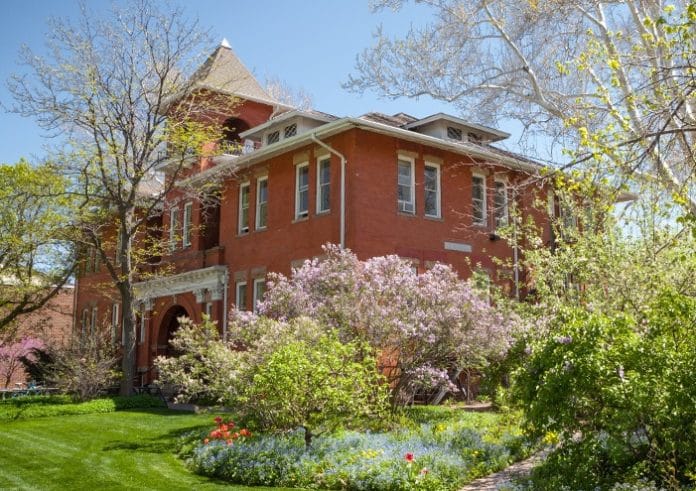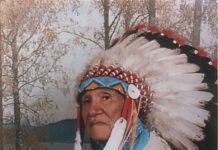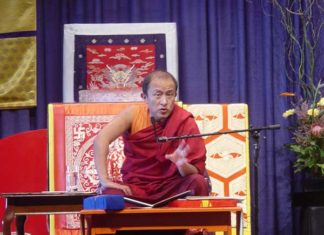
It was the summer of 1973 at Rocky Mountain Dharma Center, now called Shambhala Mountain Center—a place we mostly just called “the land.” Just a few months earlier, immediately after my last class at the University of Michigan, about a month before graduation, I moved to Boulder, arriving in April. I had been a student of the Vidyadhara for a couple years. But since there were no other fellow students in Ann Arbor, I was joining the sangha in a much bigger way than before, which had been mostly through attending week-long and weekend seminars at Tail of the Tiger and the New York Dharmadhatu during breaks from college. Rinpoche’s last comment to me, probably at Tail, was, “I’ll see you in Boulder”—responding to my query about what to do after finishing college.
I believe there were two seminars at RMDC that summer, so many dozens of us from Boulder spent almost a month on the land. During this time, John Baker and Marvin Casper, two of the most-senior students, gathered together a dozen or more of us to discuss the creation of a new college. All those assembled were in some way knowledgeable about academia—they had done graduate work, or had good connections with academics, or had even taught in a university. Having just completed a B.A. in religious studies with concentrations in Sanskrit, Pali, Asian religion, and ethnomusicology, I was among the youngest. However, I had a number of interesting professor friends, which proved useful, as time would show. (Three of them came to teach and/or study at Naropa Institute in subsequent years: Luis Gomez, and Alton (Pete) and Judith Becker.)
My purpose here is not to detail the history of how Naropa came into being (though I hope that story can be assembled and published before we’re all gone). My purpose is to focus on how the institution acquired its name. In particular, an institution of higher learning where I was among the initial seven paid employees, beginning sometime in the fall of 1973. ($72/week is what I remember as our take-home pay.)
So, back to RMDC in the summertime. I think we had two or three meetings to discuss the founding of a college. I don’t remember whether it was the first or second such meeting, but Rinpoche was present and very much participating in the discussion. It was not the first time I was in close proximity to him, but I was still pretty shy in his presence. At some point we began discussing names for the college and Rinpoche suggested Nalanda University. He was quite forceful in proclaiming this. Many of us knew how significant, influential, and long-lasting (nearly 800 years) Nalanda University of northern India had been, and most of the folks gathered seemed to rally behind his suggestion. But my instincts told me otherwise. I waited, minute-by-minute, for others to voice some opposition to the name Nalanda or to suggest an alternative name. No one did. My stomach was churning with the thought of having to be the one to oppose what my guru was saying. I sheepishly raised my hand. When Rinpoche called on me to speak and all eyes turned in my direction, my nervousness was compounded.
I said something to the effect that to name a brand-new college after one of the most revered and successful Asian institutions seemed highly presumptuous and perhaps arrogant, and it would most certainly be scorned by Buddhist academics. I said, it would be like giving the name “Harvard” to a fledgling new college. (I should have said “Oxford,” but I was fumbling for the right words.) I asked, did we really want to alienate the scholarly segment of our potential faculty and students? I implored, please, please find another name, though I couldn’t think of anything to suggest.
Some discussion ensued. I was far too terrified to put any of the comments to memory—likely still shaking from my very first foray into using some particle of intelligence to disagree with my beloved teacher. However, Rinpoche accepted my criticism, and at some point, I think at the next meeting, he suggested using the name Naropa (who was a great scholar at Nalanda), which, as we know, prevailed—and so, naming an institution of higher learning that has flourished for the past 46 years.
Less than six months later, in January 1974, I was ascending the stairs at 1111 Pearl St., our Karma Dzong Buddhist meditation center in Boulder. Rinpoche was coming along the hall from his office, moving toward the long staircase. He looked over the bannister to where I was, about five steps from the top, pointed vigorously at me, and said, “I’ve got you now!”
I replied, “What do you mean?”
He said, ”I’ve just created Nalanda Foundation, so what do you think of that?”
I asked him what the Foundation was meant to be. He explained that the Nalanda Foundation would be our overarching nonreligious, secular, nonprofit institution, and that Naropa would be a part of that entity. I replied that it all sounded very good and that as long as the Foundation wasn’t called Nalanda University, he had my support. The more I thought about it, Nalanda as the name of a foundation seemed like a great usage of the venerable word. The creation of the Nalanda Foundation was a wonderful completion of our summer discussions on the land, and registrations for the upcoming first summer sessions at Naropa Institute were already rolling in daily in large numbers.
















